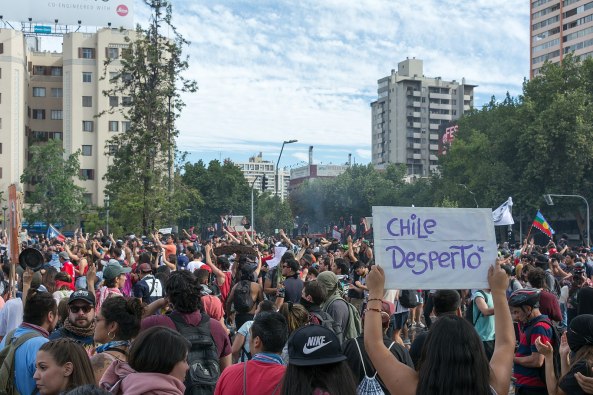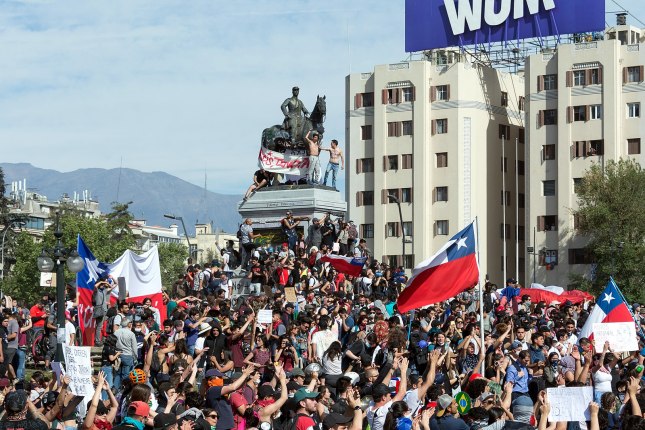Chileans know how to protest. They show up en masse and beat pots and pans, cacerolazo is their name for it. This month they’ve returned to the streets as they did in the days of Dictator Pinochet. Chilean protests are very lively and incarnate the democratic core of the country.
What happened? Why are there protests in one of the most stable countries in South America? Why has Piñera set an 11 pm curfew for two weeks in retaliation?
The recent metro fare hike set struggling Chileans on edge. High school students acted out by jumping over subway turn styles, skipping payment. A few people went violent, burning subway train cars, others looted stores. Piñera reacted with a stone hand, declaring, “We are at war” and imposing martial law.
Chileans are protesting financial inequality. Their signs read, “We are not at war” and “Piñera resign.” The protesters want justice, economic parity, and peace.
October 25, people in Santiago marched against the Piñera government and the armed forces who used brutal methods to keep Chileans in line. So far 18 civilians are dead, more than 250 are wounded and over three thousand were arrested.

Piñera erased the fare increase, has increased the minimum wage a bit, has restructured Congress, and is taking about improving health care. Chileans want more. They seek a new constitution, one not connected with the dictatorship. The people want better living conditions. Piñera is smiling and conciliatory, but the Chileans aren’t buying it. Protest signs read, “Chile despertó,” Chile has awakened. Friday October 25 over a million Chileans protested in Santiago. The number of people marching in other major cities like Valparaíso, Arica and Antofagasta were also large.

We are following our dear friends’ experiences through what they post on social media. The Chilean example shows us at least 5 ways to make our voices heard, should we ever need to protest:
5. Record police brutality with your cell phone
4. Upload your photos and videos to social media, even when a few are “not currently available” (unexplainably disappear)
3. Stay in contact with friends abroad to disseminate information. We’re here for you!
2. Protest; bring friends, family and neighbors.
1.Show up fearlessly and make a lot of noise; beat pots, play instruments, and sing the anthem, “¡El pueblo unido jamas será vencido!” The people united shall never be divided!” The sister anthem is Victor Jara’s El derecho de vivir en paz; The Right to Live in Peace.
Meanwhile, the Chilean marches continue daily. I admire their strength, resilience and determination. May paz prevail. ¡Chi-chi-chi-le-le-le!
Gracias for reading Fake Flamenco! ¡Olé! -Rebecca

I admire the Chileans’ active protests as I have just come from an American protest to the way ICE trays immigrants and asylum seekers. We were also advocating making Minnesota a “sanctuary state”. I must admit it has taken me awhile to get there but it is in the spirit of the inscription on the Statue of Liberty.
LikeLiked by 2 people
Good to hear about your continued activism. Yes, give me your poor, your tired, your hungry” still is important. Would Mn be the first asylum state?
LikeLiked by 1 person
I can’t thank you enough for this. As an American just learning Spanish, who has become really interested in Chile, I have been trying to understand everything that is happening there now. You have given me a good foundation. The beating of pots and pans is curious. Do you know the origin of that? Gracias 🙂
LikeLiked by 3 people
Thanks for your comments, Laurie! I’m glad my summary was helpful. The majority of Chileans are struggling to get by, They’ve just gone from making less than $420/month= $14/day to making $16. That is at the core of the protests, because people can’t live on the low wages. The cacerolazo has a long history and an interesting twist. Under socialist President Salvador Allende, the high society ladies would bang their pots in pans in protest in the 1970s when there weren’t enough goods on the grocery store shelves. (the store owners hid the goods and sold them on the black market) Later, when Pinochet became dictator, regular folks reappropriated the cacerolazo. Four strokes of genius of this tactic: 1. you can protest by or in your house and hide when the authorities come; 2. every home has a pot to beat; 3. perfect rhythym like with a drum is not important; 4. newspapers can under-report protest turn outs, but if you heard the noise of all the cacerolazo, you know a lot of people were protesting. Buena suerte con tu español! R
LikeLiked by 1 person
I had no idea!
LikeLiked by 1 person
We in the USA hear the most about local news or news from Washington DC. In Chile, they are still protesting daily and when I go to look at Chilean friends’ FB posts, their videos happen to be “unavailable at this time”, which reflects censorship. It’s a big social movement. I hope they have a positive outcome from speaking out about inequality. -Rebecca
LikeLiked by 1 person
All great ways to make noise and be heard! I agree with all of these!
LikeLiked by 1 person
Thanks, Carol Anne!
LikeLiked by 1 person